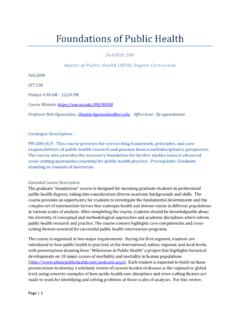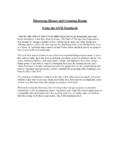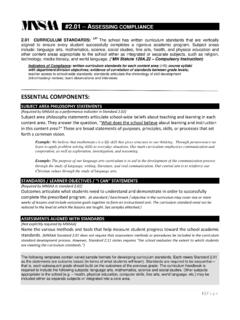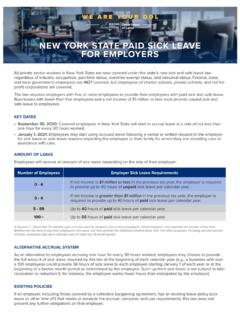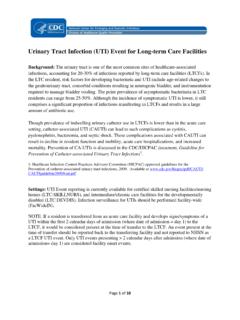Transcription of The Consonants of American English
1 1 The Consonants of American English Marla Yoshida How do we describe Consonants ? Consonants are sounds in which the air stream meets some obstacles in the mouth on its way up from the lungs, as we learned earlier. Most Consonants are not as smooth-sounding as vowels; they pop, hiss, snap, or hum. The table below shows the phonemic symbols for American English Consonants . There are alternate symbols for a few of these sounds, but overall, the consonant symbols are very consistent across different versions of the phonemic alphabet, and they are basically the same for American English and British English . Consonants of American English Example Symbol Example Symbol pot /p/ shop / / or / / book /b/ beige / / or / / take /t/ house /h/ dog /d/ chip / / or / / cat /k/ jump / / or / / good / / man /m/ fun /f/ now /n/ very /v/ sing / / thick / / lamp /l/ then / / road /r/ sun /s/ win /w/ zoo /z/ you /y/ or /j/ (why) (/hw/) Most speakers of English don t use /hw/ as a separate phoneme.
2 They use /w/ instead. 2 Most words in English contain at least one consonant , and some contain many more . For example, at and she each contain one consonant sound, play contains two, and spring contains four. (Remember that we re counting the consonant sounds, not the consonant letters.) But words don t have to have any Consonants at all. For example, the words I, a, and oh have no consonant sounds only vowels. Phonologists classify Consonants by describing these three sets of categories: Voicing Place of articulation Manner of articulation Voicing When the vocal cords are stretched tight so that they vibrate during the pronunciation of a sound, we say that the sound is voiced. Sounds that are produced without vibration of the vocal cords are called voiceless.
3 To tell if a sound is voiced or voiceless, touch your throat gently as you say it. When you say a voiced sound, you can feel a vibration or buzzing in your throat. For a voiceless sound, you can t. You can also feel the voicing of sounds by putting your fingers in your ears. When you say a voiced sound, it will seem louder. When you say a voiceless sound, it won t. When you do this with students, try to say only the sound you re listening to, without a vowel after it. For example, to practice /t/, say only /t/, not /t / or /tiy/. If you pronounce a vowel after /t/, the voiced vowel will cause vibration and students will be confused and might mistakenly think that /t/ is voiced. Many of the Consonants of English form pairs a voiced and a voiceless sound that are the same except for voicing.
4 For example, /b/ and /p/ are identical except that /b/ is voiced and /p/ is voiceless. (Notice that one of these pairs the voiceless sound / /and the voiced sound / / are both spelled with the same two letters: th.) However, the voiced sounds /m/, /n/, / /, /l/, /r/, /w/, and /y/ have no voiceless counterparts, and the voiceless sound /h/ has no voiced counterpart. The box on the next page shows the voiced and voiceless consonant sounds of English . Paired sounds in boxes next to each other. If a sound has a gray box next to it, it has no paired sound. 3 Voicing of English Consonants Voiced Consonants Voiceless Consonants /b/ big /p/ pen /d/ dog /t/ top / / give /k/ cat /v/ vote /f/ food / / this / / thick /z/ zoo /s/ sun / / beige / / ship /h/ house /d / juice /t / chip /m/ man /n/ now / / sing /l/ love /r/ run /w/ wet /y/ yes Place of articulation (Where?)
5 We can also classify Consonants by referring to the parts of the articulatory system that are active when we produce each sound. This is called the place of articulation. As you can see in the list below, some of these terms are similar to the names of the parts of the articulatory system that are used in making them. Bilabial: Both lips touch or almost touch. The sounds in this group are /p/, /b/, /m/, and /w/. Labiodental: The upper teeth softly touch the lower lip. The sounds in this group are /f/ and /v/. Dental (also called interdental): The tip of the tongue touches the bottom edge of the top teeth or between the teeth. The sounds in this group are / / and / /. Alveolar: The tip of the tongue touches or almost touches the alveolar ridge (the tooth ridge).
6 The sounds in this group are /t/, /d/, /s/, /z/, /n/, and /l/. Palatal (also called alveopalatal): The blade of the tongue touches or almost touches the hard palate. The sounds in this group are / /, / /, / /, / /, /r/, and /y/. 4 Velar: The back of the tongue touches the soft palate. The sounds in this group are /k/, /g/, and / /. Glottal: There is friction in the glottis (the space between the vocal cords). The only phoneme in this group is /h/. Manner of articulation (How?) There is often more than one sound that is pronounced in the same part of the mouth, that is, with the same place of articulation. To distinguish between these similar sounds, we can describe their manner of articulation.
7 This tells how we produce a particular consonant sound whether it comes out smoothly or roughly, whether it s like a pop or a hiss or a hum. The manners of articulation for English Consonants are listed below. Stops (also called plosives): The air stream is blocked completely somewhere in the mouth, air pressure builds up, and then it s released, like a tiny explosion. The stops in English are /p/, /b/, /t/, /d/, /k/, and /g/. Fricatives: The air stream is compressed and passes through a small opening in the mouth, creating friction a hissing sound. The air stream is never completely blocked, so the sound can continue. The fricatives are /f/, /v/, / /, / /, /s/, /z/, / /, / /, and /h/. Affricates: A combination of a stop followed by a fricative an explosion with a slow release.
8 The affricates are / / and / /. Each of these symbols is made up of two parts a stop symbol and a fricative symbol. This reminds us that the sounds also have two parts. Nasals: In these sounds, the tongue or lips block off the vocal tract so air can t go out through the mouth. Instead, the passage leading up into the nose opens so that the air stream can go out through the nose. The sounds in the nasal group are /m/, /n/, and / /. Liquids: These are sounds that are pronounced very smoothly, like water flowing in a river. The air stream moves around the tongue in a relatively unobstructed manner. The liquid sounds in English are /l/ and /r/. Glides (also called semivowels): A glide is like a very quick vowel.
9 For this reason, they re sometimes called semivowels, which means half-vowels. They sound like vowels, but they can function as Consonants . The glides in English are /w/ (which sounds like a quick /uw/) and /y/ (which sounds like a quick /iy/). 5 Summary: The Consonants of English Classification of American English consonant Phonemes Manner of Articulation Place of Articulation Bilabial Labio-dental Dental Alveolar Palatal Velar Glottal Stop Voiceless Voiced /p/ /b/ /t/ /d/ /k/ / / Fricative Voiceless Voiced /f/ /v/ / / / / /s/ /z/ / / / / /h/ Affricate Voiceless Voiced / / / / Nasal Voiced /m/ /n/ / / Liquid Voiced /l/ /r/ Glide Voiced /w/ /y/ An almost-extinct consonant sound: /hw/ Most speakers of English today pronounce the first sounds in weather and whether in the same way: as the voiced glide /w/.
10 However, until fairly recently, these were two separate sounds. Words like weather, woman, and wish started with a voiced /w/, and most words spelled with wh, like whether, which, and what, started with a different sound, a voiceless glide that can be represented by the symbol /hw/. Gradually the /hw/ sound has been going out of use. Today the main areas where many people distinguish these two sounds are Scotland, parts of Ireland, and some parts of the Southern United States. In other areas, some speakers may differentiate between /w/ and /hw/, but most people don t. For pronunciation teaching purposes, it s not necessary to teach students to use the /hw/ sound unless your textbook teaches it.

